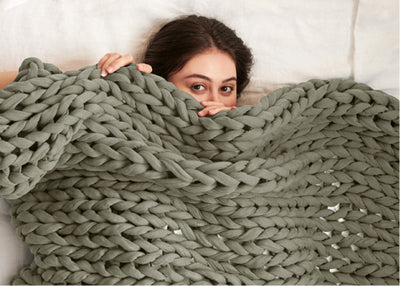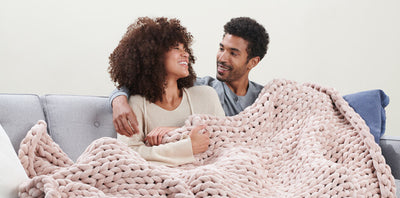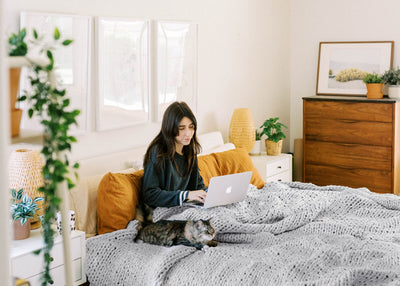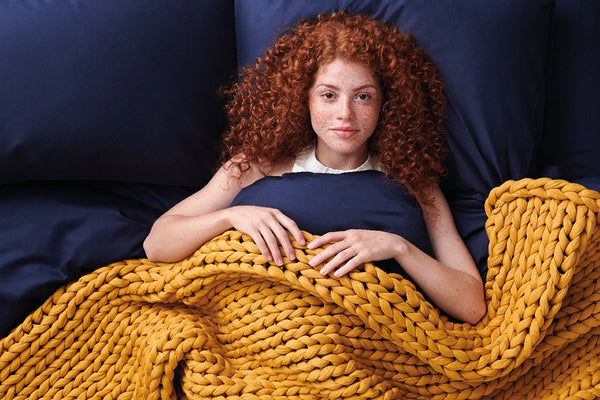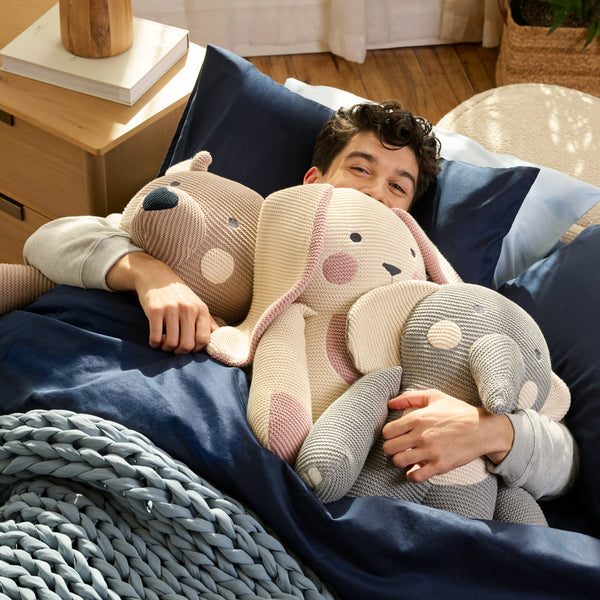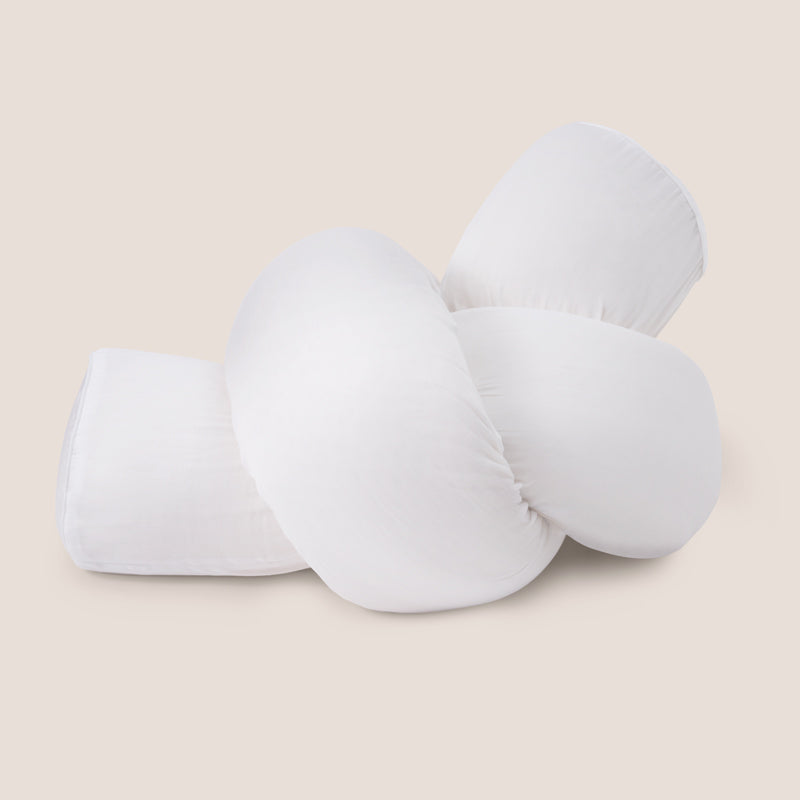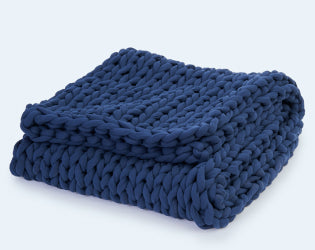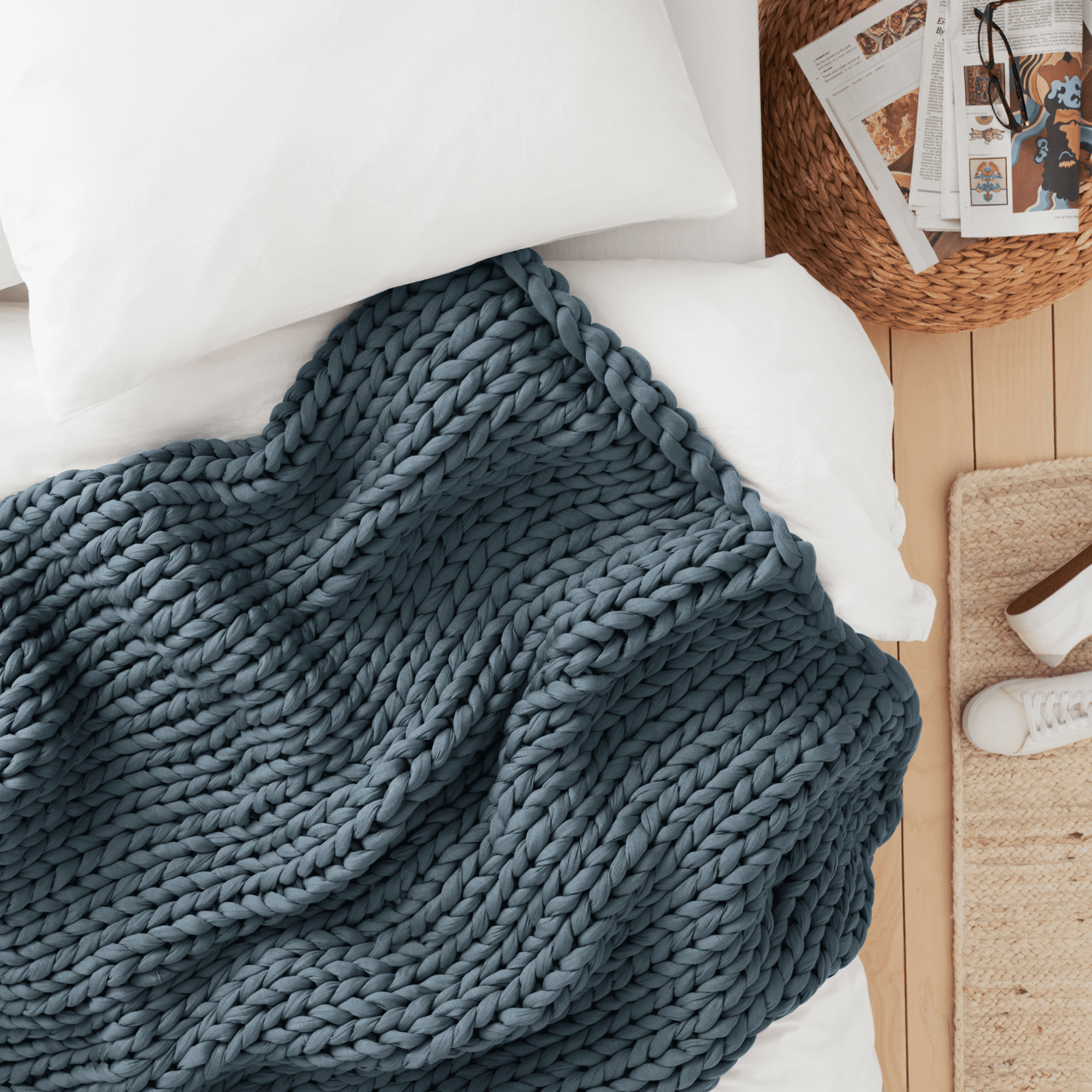Sleep Apnea Self-Care: Home Remedies & Practical Tips
This blog discusses ways to practice self-care if you experience sleep apnea. We also share practical tips and home remedies that could help improve your overall sleep quality.

Bearassentials
Sleep apnea is a sleep disorder characterized by breathing interruptions during sleep.
Left untreated, it can lead to hypertension, heart disease, and impaired cognitive function.
Self-care tips for sleep apnea include weight management, positional therapy, and throat exercises.
Did you know?
Sleep apnea is more common in men than in women. However, the risk for women increases during pregnancy and after menopause.
Whether you need guidance for yourself or a loved one, in this blog, you will find insights on sleep apnea and self-care. We delve into types of sleep apnea, specific symptoms to watch out for that will require medical advice, and effective home remedies for improved sleep.
Let’s begin with the basics!
What Is Sleep Apnea?
Sleep apnea, also known as sleep apnoea, is a sleep disorder characterized by pauses in breathing or instances of shallow or infrequent breathing during sleep. These pauses can last for a few seconds to several minutes and may occur multiple times per hour. The most common types of sleep apnea are:
Obstructive Sleep Apnea (OSA): This happens when the muscles at the back of your throat relax more than usual, leading to a temporary narrowing of the upper airway. As a result, breathing is disrupted or reduced.
Central Sleep Apnea (CSA): This type of sleep apnea is less common and is caused by a failure of the brain to send appropriate messages to the muscles that control your breathing. Unlike OSA, there is no physical obstruction in the airway; instead, the brain simply forgets to tell the muscles to breathe.
Complex Sleep Apnea Syndrome: This is also known as “treatment-emergent central sleep apnea” – a less common condition that occurs when you have both obstructive sleep apnea and central sleep apnea.
So, how exactly can you know if you are experiencing sleep apnea? Let’s take a look at the most common symptoms in the next section!
Symptoms Of Sleep Apnea
Sleep apnea can show up through a variety of symptoms, and it’s essential to remember that not everyone with sleep apnea will have all of these symptoms. Some common signs include:
- Loud snoring
- Pauses in breathing
- Frequent nighttime urination
- Morning headaches
- Dry mouth or sore throat in the morning
These symptoms can also be caused by various sleep disorders or other health conditions. If you suspect that you may be experiencing sleep apnea, you will need to consult a medical professional for a proper diagnosis.
So, are there ways of getting rid of sleep apnea? Let’s look at whether there is a cure for this disorder in the next section!

Is There A Cure For Sleep Apnea?
There is no definitive “cure” for sleep apnea, but effective treatments and management strategies can significantly reduce its symptoms and improve your quality of life. The appropriate treatment approach depends on the type and severity of sleep apnea. These changes will include lifestyle changes, physician-recommended machines, oral appliances, positional therapy, and even surgery.
Beyond medical interventions, there are also lifestyle changes you can start practicing at home to manage the symptoms of sleep apnea. Let’s discuss these next!
Home Remedies For Sleep Apnea
Are you looking for sleep apnea cures without a cpap machine? Well, we’ve got you! While lifestyle changes and home remedies may not replace professional medical treatment, they can complement standard therapies and improve overall sleep quality. Consider the following tips:
1. Weight Management: Losing excess weight, if applicable, can help reduce the severity of obstructive sleep apnea. Even a modest loss of weight may lead to notable improvements in your sleep quality.
2. Positional Therapy: There are better sleep positions for sleep apnea than, say, sleeping on your back. Sleeping on your side, for instance, may help prevent airway obstruction. Consider using a body pillow to maintain a side-sleeping position. Our Cuddler provides ergonomic support, helping to ensure proper spinal alignment during the night.
3. Elevate the Head of the Bed: Raising the head of the bed by a few inches can help reduce the likelihood of the tongue and soft palate collapsing to the back of your throat, potentially improving airflow.
4. Avoid Alcohol and Sedatives: Alcohol and sedative medications can relax the muscles in the airway, contributing to airway collapse. Avoiding these substances, especially close to bedtime, may be beneficial.
5. Quit Smoking: According to some studies by the National Institutes of Health (NIH), smoking can increase inflammation and fluid retention in the airway, worsening obstructive sleep apnea, especially. Quitting smoking can have numerous health benefits, including potential improvements in sleep apnea symptoms.
6. Regular Exercise: Engaging in regular physical activity can contribute to weight loss and improve overall cardiovascular health. Exercise can also help reduce the severity of sleep apnea symptoms.
7. Establish a Regular Sleep Schedule: Going to bed and waking up at the same time every day helps regulate the body’s internal clock. Consistent sleep patterns can improve the overall quality of your sleep.
8. Nasal Decongestants: If you experience mild sleep apnea or nasal congestion, over-the-counter nasal decongestants may help open nasal passages and improve breathing. However, these should be used under the guidance of a healthcare professional, as overuse can have adverse effects.
9. Throat Exercises: One study by the NIH suggests that regular throat exercises may help strengthen the muscles in the airway and reduce the severity of sleep apnea. Always consult with a healthcare provider or a speech therapist for appropriate exercises.
While these home remedies are beneficial, it is important to note that they are not a substitute for professional medical advice or treatment.
In some cases, medical professionals may recommend sleep apnea machines as a remedy. Here’s what you need to know about the appliances you can use for sleep apnea self care while at home.
What Are Sleep Apnea Machines?
Continuous Positive Airway Pressure (CPAP) machines are commonly used to treat sleep apnea, especially obstructive sleep apnea (OSA). These machines deliver a steady stream of air to keep the airway open during sleep, preventing pauses in breathing. Here are the key components and types of sleep apnea machines:
1. Basic CPAP Machines consist of a small air pump connected to a mask that covers the nose, mouth, or both. The machine delivers a continuous and steady stream of pressurized air to prevent the airway from collapsing.
2. BiPAP Machines (Bi-level Positive Airway Pressure) provide two levels of air pressure: a higher pressure during inhalation and a lower pressure during exhalation. This may benefit people who find it challenging to exhale against continuous pressure, and it can be prescribed for certain types of sleep apnea or respiratory conditions.
3. Auto-adjusting CPAP (APAP) Machines adjust the air pressure based on your breathing patterns throughout the night. This can be useful for those whose pressure needs vary during different sleep stages.
4. Adaptive Servo-Ventilation (ASV) Machines are designed for treating central sleep apnea (CSA) and complex sleep apnea syndrome. They monitor breathing patterns and adjust air pressure to maintain normal breathing.
5. Travel CPAP Machines are compact and portable CPAP machines are available for individuals who travel frequently. These devices are designed to be lightweight, easy to carry, and suitable for use in various environments
Key Components:
Humidifier: Many CPAP machines come with a built-in humidifier or have a humidifier attachment. The humidification helps prevent dryness and irritation in the nose and throat.
Mask: Masks come in various styles, including nasal masks, full-face masks, and nasal pillows. The choice of mask depends on your comfort and the type of sleep apnea being treated.
Tubing: The tubing connects the machine to the mask and allows the pressurized air to reach the airway. It should be kept clean to ensure optimal performance.
Filters: Regularly changing filters is essential to maintain the cleanliness and effectiveness of the CPAP machine. Filters help prevent dust and particles from entering the airway.
CPAP machines are one of the most common sleep apnea remedies. This is why it is crucial to work closely with a healthcare professional, sleep specialist, or respiratory therapist, to determine the most suitable type of machine for you.
Next, let’s look at tips for bed partners of individuals with sleep apnea.
Sharing A Bed With Someone With Sleep Apnea
Several strategies can help bed partners get a restful night’s sleep, despite one of you experiencing sleep apnea. These include:
1. Encourage Seeking Treatment: Effective treatment options, such as Continuous Positive Airway Pressure (CPAP) therapy or other interventions recommended by healthcare professionals, can significantly reduce symptoms such as loud snoring.
2. Use White Noise or Background Music: This can help drown out the noise from a CPAP machine or any other sounds associated with sleep apnea, creating a more peaceful sleep environment for both bed partners.
3. Adjust Sleep Positions: Experiment with different sleep positions to find what works best for both of you. Elevating the head of the bed slightly may help alleviate snoring and reduce the severity of sleep apnea.
4. Separate Blankets if Necessary: If the movements associated with adjusting the CPAP mask or any other sleep apnea-related actions disturb your sleep, consider using separate blankets. This way, adjustments can be made without affecting your comfort.
5. Create a Relaxing Bedtime Routine: Establish a calming bedtime routine that both .partners can follow. This can include activities like reading, dimming the lights, or engaging in relaxing activities like meditation to prepare the body and mind for sleep
6. Maintain Consistent Sleep Schedules: Try to maintain consistent sleep schedules, going to bed and waking up at the same time each day. This can help regulate sleep patterns and improve overall sleep quality.
7. Discuss and Communicate: Open communication is key. Discuss any concerns or challenges related to sleep apnea and work together to find solutions. This can include discussing how both partners can get better sleep and addressing any issues that arise.
Supporting your bed partner in their journey to manage sleep apnea is crucial. Encourage them to stay consistent with treatment and maintain a healthy lifestyle to improve overall sleep quality.
Next, let’s look at what symptoms you need to check for to seek timely medical help for sleep apnea.

When To See A Doctor
The pauses in breathing characteristic of sleep apnea can lead to a range of health issues, including disrupted sleep, daytime fatigue, and an increased risk of conditions such as hypertension, heart disease, stroke, and diabetes. This is why it is vital to know when you need to see a doctor for a more detailed diagnosis. Here are some signs to look out for:
- Persistent snoring, especially if it is accompanied by snorting or choking sounds
- Witnessed pauses in breathing during sleep, reported by a bed partner or family member
- Excessive daytime sleepiness despite what should be a full night’s sleep duration
- Waking up with frequent headaches, especially in the morning
- Waking up with a dry mouth or sore throat may indicate mouth breathing during sleep
- Impaired daytime performance, like difficulty remembering things and concentrating
- Uncontrolled or treatment-resistant high blood pressure
If you experience one or more of these signs, consult a healthcare professional for a more detailed evaluation. A sleep study, or polysomnography, may be recommended to assess the severity and confirm the specific type of sleep apnea.
Conclusion
Sleep apnea is a common sleep disorder that can interfere with sleep quality and daytime functioning. It helps to recognize the symptoms, practice good sleep hygiene, and seek professional diagnosis and treatment procedures. From lifestyle changes and home remedies to advanced treatments like CPAP machines, there is a range of options to enhance your sleep quality and support overall well-being.

